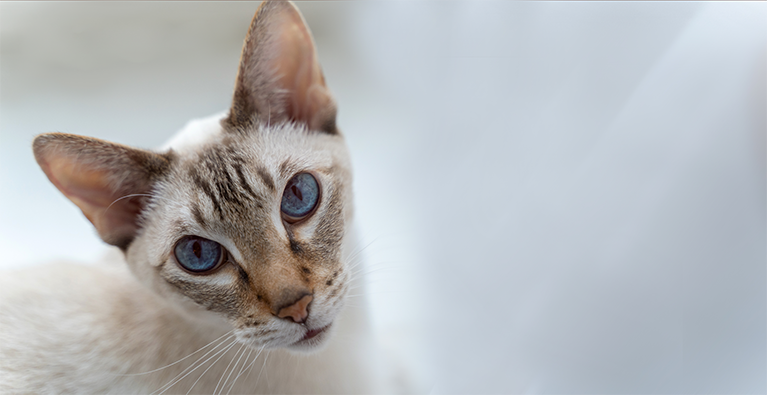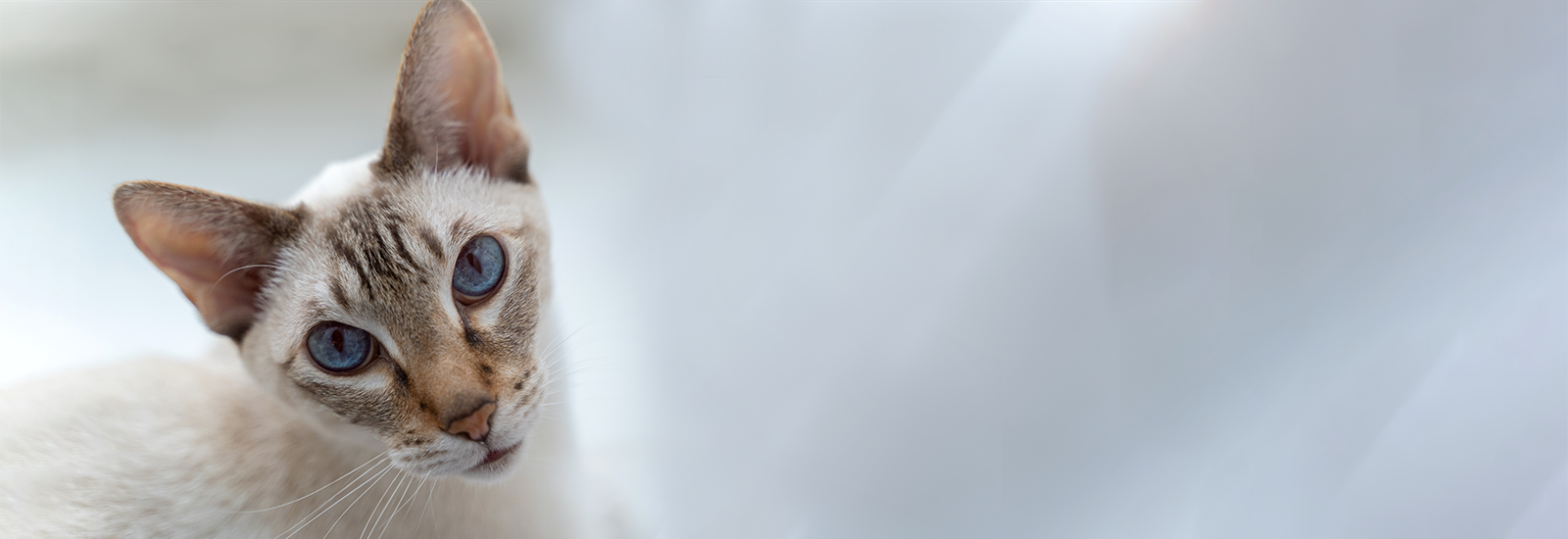Oriental Shorthair
The Oriental Shorthair is descended from the Siamese cat. Unlike the Siamese, it has green eyes and a much wider variety of colours. However, there are no differences whatsoever regarding its talkativeness and friendliness.
Profile of the Oriental Shorthair
- Size medium
- Weight female: approx. 3.5 kg, male: approx. 4.5 kg
- Origin England
- Build slender, graceful
- Length of fur short, shiny
- Colour of fur very wide range of colours
- Grooming minimal
- Behaviour talkative, playful
- Character affectionate, intelligent
Appearance and character of the Oriental Shorthair
Without question, an Oriental Shorthair has a unique appearance. Firstly, there is the shape of its head. This does not have the typical round form, but is triangular, with an elongated profile, a long straight nose, large pointed ears and slightly slanted eyes. This alone gives it an oriental look, and this is emphasised by its long, elegant and very slender body. Oriental Shorthairs are sleek and muscular, and their shoulders are wider than their hips. Not only are their legs long and slender, but also their thin tails, which have a fine point at the end.
The Oriental Shorthair has virtually the same family tree as the Siamese cat. The only difference is the colour. It has green eyes instead of blue. Instead of a light-coloured coat with “points”, its fur can be very colourful: the range of colours extends from white, cream, blue, red and chocolate to deep black. The breed standard also allows patterns such as smoke, tortie, shaded and tabby.
Not only does the Oriental Shorthair have an exuberant variety of colours, but it is also quite a character. It is a real diva that loves to be in the limelight: its talkativeness and extensive vocalisation is near legendary. It always has something to comment on, to share, to ask for, or to complain about. It meows, “sings”, chatters away and purrs, all depending on what it believes is required at any particular time. If its food bowl is empty, if nobody is playing with it, or if a cuddling session is overdue, it will not simply accept the situation; this intelligent, spirited breed of cat will communicate this loudly and clearly.
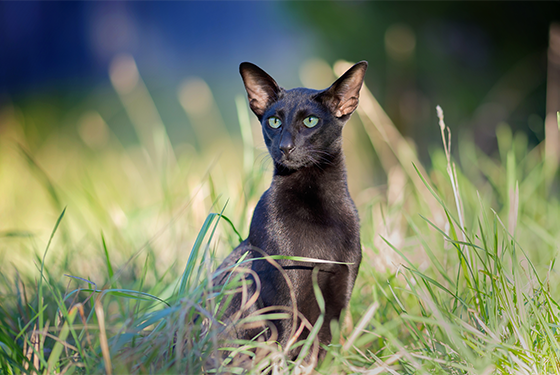
Keeping and caring for an Oriental Shorthair cat
Like almost all breeds of cat, the Oriental Shorthair prefers to have another cat by its side. It will then be able to chat with them for hours on end if necessary or simply complain about being left alone for too long. This is something that it does not like at all, which is why some owners even report that their pets prefer to travel in a carrying box or wearing a cat harness and lead rather than waiting at home for their owners to return. If this cannot be avoided, then you should make sure that your cat has plenty of things to keep it occupied in your home. A tall cat tree is ideal for this, as are cuddly caves, activity fun boards and plenty of toys. Intelligence toys are also a good option. Many cats are very interested in these, and are also keen to learn little tricks.
The grooming requirements of the Oriental Shorthair are hardly worth mentioning. It has virtually no undercoat and very short, silky fur. In principle, all you have to do is occasionally run over their coat with a soft cloth or brush. This will give it a good shine and remove any loose hair and flakes of skin. You should also inspect the fur and skin to make sure that everything is healthy. Please bear in mind that this breed’s thin coat only provides limited protection against the cold. In winter, it is therefore important to provide cosy places for your pet, and a pleasant room temperature. If the Oriental Shorthair is allowed to go outdoors, which is no problem in principle but not absolutely necessary, make sure that it is able to easily return indoors when it is cooler outside so that it does not catch a cold.
Nutrition
Whether it’s a kitten, an adult cat or a senior – the food for an Oriental Shorthair cat should always be of high quality and tailored to its age. Cats are carnivores by nature, so cat food should always contain a high proportion of meaty ingredients. Sugar, flavour enhancers and artificial colourings and preservatives do not belong in the food.
animonda has the ideal food for every stage of your cat’s life. You can choose between kitten, adult and senior cat food. The products are specially formulated to meet the specific nutritional requirements of the different life stages of cats. This provides the best foundation for your pet to enjoy a long and healthy life.
Oriental Shorthair: health
The Oriental Shorthair is generally a healthy breed of cat with no conspicuous hereditary diseases. Unfortunately, however, the gene pool is relatively limited. As a result, there is the risk of illness or immunodeficiency.
In order to produce healthy animals, responsible breeders always have genetic tests carried out on their animals and exclude any cats with health issues from breeding. Make sure that you find a reputable breeder who is able to document their commitment with health certificates.
Despite preventive health care, hereditary diseases can occur. For the Oriental Shorthair, these include various heart and eye disorders. One of these is progressive retinal atrophy (PRA). In the medium term, this leads to blindness in the cat. There are also occasional reports of anaemia. This results in a lack of red blood cells, which is noticeable in the form of fatigue and a high respiratory rate.
History and breeding
There is a good reason why the Oriental Shorthair and the Siamese cat share a breed standard. This is because the Oriental Shorthair evolved from the Siamese. This split was caused in the 1920s. Until then, the guidelines for breeding Siamese were very varied, however there have been continuous changes since the first breed standard was drawn up in 1892. These culminated in only light-coloured, blue-eyed cats with points, i.e. darker markings on the head, paws and tail, being allowed.
The restrictions included in the breed standard led to discontent among some breeders – and Baroness von Ullmann in particular. The English breeder did not comply with the changes and decided to pursue a different approach to breeding. Here, she not only made use of the different colours of the Siamese, but also introduced crossbreeding with Abyssinian and Russian Blue cats. As a result, she made a wide variety of colours possible, which is still reflected in the breeding of the Oriental Shorthair today. Only very rarely do two of these cats look alike, which provides plenty of choice for prospective owners.
The Oriental Shorthair was recognised by the European governing body, FIFe, in 1959. In addition, there is the Oriental Longhair, which originated as a by-product of the (long-haired) Balinese cat, which is also a descendent of the Siamese. Each of these cats is a separate breed, but due to their close relationship, all four share the same breed standard. They only differ in a few individual details.
You may also like this
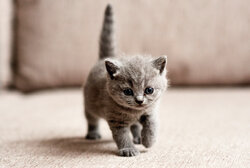
Feeding kittens - nutrition tips
What small kittens need for healthy development
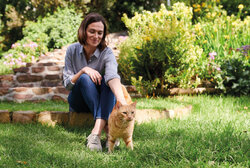
Good cat food
How to recognize good cat food for your darling
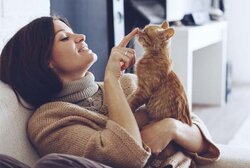
A kitten is moving in
Tips for collection, initial equipment and settling in
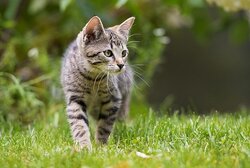
Getting your cat used to being outdoors
How to get your cat used to going outside
